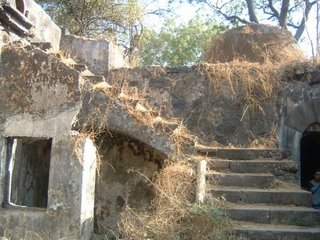


Last week Swine Flu besieged the city and many parts of the country. A few deaths across the country had most people hit the SOS button. The panic stricken people in a desperate attempt to curb the epidemic lined up at hospitals for tests, closed schools and colleges and kept their children away from the crowds, stayed away from Malls(well....mostly....except when there were huge sales at throw away prices), theaters stayed closed for 3 days, people cancelled travel plans...
We'd had enough of the madness!!! The media has added to the panic and at the same time has maintained that more people have died this year, as every year, from common flu, diarrhea, TB, etc.
Swine flu is definitely a cause for concern but there is no reason for panic.
We wanted to get away from it all! Six friends, a hired car and some music...we hit the road!!
This weekend we were tired and didn't really want to trek but we definitely wanted to get out of the city. Korlai Fort or El Morro like the Portuguese called it seemed like the perfect getaway. Its strategic position overlooking the Revdanda creek, its historical background, the promise of seafood because of its proximity to the coast, the opportunity for good photography, all made it the perfect choice for our Sunday Outing.
The drive to the fort was beautiful. It was a cloudy morning and after a hearty breakfast of pohe, vadapav,kharwas,sabudana khichadi and masala chai at Datta(Panvel)we hit NH17.
The drive was scenic...clouds enveloped the Karnala Pinnacle, the hopeful monkeys lined the highway waiting for snacks and treats from the passing cars, a little ahead the villages ran alongside the road, the lush green fields of paddy, the various gourds that grew on vines that snaked up poles and nets kept to tame them, the villagers setting up their daily stalls selling fresh farm produce....
As we neared Alibaug the roads turned into gallis, old houses with tiled roofs surrounded by palms stood in stark contrast to the posh villas. We could smell the sea in the distance and we grew impatient to reach the fort.
As we crossed the Revdanda creek the fort came into sight.
Located on a little hill and surrounded by water on three sides, the fort is at an approximate height of 300 feet above sea level. The whitewashed walls of the church on top are visible from a distance.(The ruins of the ancient church are being restored)
Korlai Fort or Castle Curlew or El Morro although built and used primarily by the Portuguese was at various points also under the Nizam, Maratha and finally the British rule. Though the main entrance to the fort faces the East you can drive right to the base from the West through the Korlai village. A Naval lighthouse stands at the base and is operated by 4 men who live in its premises. We climbed to the top of the lighthouse and spent sometime with the coast guard who told us about its operations- the beacon, the focus points, the distance to which the light travels at night, etc
Approximately 150 steps lead to the top of the fort. The fort commands a view of the Revdanda creek and the Revdanda Fort on one side, the Arabian Sea to the West and the Korlai Village and the Korlai Beach to the other side. The ancient church, a number of cannons on the bastion, a breathtaking view of the creek with the fishing village, a temple, colourful boats bobbing on the water, cattle grazing in the distance...I'd almost forgotten that it was no longer the cloudy day it started out to be. The sun was blazing and my skin was two shades darker(I'd forgotten to wear my sunscreen), we'd finished our supply of water, it was nearing 3pm and our stomach's were screaming from hunger. We'd spent almost four hours atop the fort.
Someday I'd love to watch the sunset from the fort or even lie in my sleeping bag and listen to the sea while i watch the innumerable stars on a winter night.
As we drove back we realised that in this part of the sleepy world it was too late to get lunch. Fortunately at Alibaug a little eatery(Khanaval) was open and we lunched on Mutton Thali with Fried Pomfret. I've been wanting to eat at the Patil Khanaval at Murud for ages. This little place, although its namesake, and our saviour didn't offer the mouthwatering lunch that I expected. Nonetheless the food was decent and we were starving.
On the drive back to the city we bought all sorts of gourd from the villagers-bitter, snake, etc. not so much for our love of food but more from the excitement at buying straight from the hands that sow the crop and reap it.
This will probably be our last trek for the season. The rain has vanished and the heat is slowly becoming unbearable. A lot of ambitious plans have been chalked out for Winter treks in the Sahyadris. So....until the next trek....I have some wonderful memories from the many treks this Monsoon.


















